In the heart of Karnataka, atop a cluster of rocky hills, stands Chitradurga Fort – a majestic testament to the region’s rich history and architectural brilliance. This imposing fortress, with its colossal stone walls and intricate bastions, has witnessed centuries of conquests, battles, and triumphs, solidifying its place as one of Karnataka’s most iconic landmarks. Entering the sprawling complex is like stepping into a time machine. Every stone whispers tales of valor and resilience. From its ancient origins as a Nayaka stronghold to its later occupation by legendary rulers like Hyder Ali and Tipu Sultan, the fort’s storied past is etched into its rugged facade and labyrinthine passages.
But Chitradurga Fort transcends its role as a historical relic. It’s a living testament to Karnataka’s vibrant cultural heritage and architectural ingenuity. Beyond its formidable ramparts lies a treasure trove – temples, tanks, and gateways – each bearing the mark of the artisans and craftsmen who sculpted them centuries ago.
How to reach:
By Road:
Chitradurga is well-connected by road to major cities like Bangalore, Hubli, and Mangalore. National Highway 48 (NH48) passes through the city, making it easily accessible by car, bus, or taxi. From Bangalore, Chitradurga is approximately 200 kilometers away, and the journey takes around 3 to 4 hours by road, depending on traffic conditions. Several state-run and private buses operate between Bangalore and Chitradurga at regular intervals, providing an affordable and convenient mode of transportation.
By Train:
Chitradurga Railway Station is the nearest railhead to Chitradurga Fort, located at a distance of about 4 kilometers from the fort. Several trains connect Chitradurga to major cities like Bangalore, Mysore, Hubli, and Bellary. From the railway station, you can hire a taxi or auto-rickshaw to reach Chitradurga Fort.
By Air:
The nearest airport to Chitradurga is Hubli Airport, located approximately 200 kilometers away. However, it has limited connectivity. The nearest major airport with better connectivity is Kempegowda International Airport (BLR) in Bangalore, which is about 220 kilometers from Chitradurga .
Local Transportation:
Once you reach Chitradurga town, you can hire auto-rickshaws or taxis to reach Chitradurga Fort. If you prefer to explore at your own pace, you can also rent a car or motorcycle from rental agencies in the town .
Best time to visit:
Pleasant Winters (October to February):
Winter reigns supreme for exploring Chitradurga Fort. Enjoy comfortably cool weather, ideal for sightseeing and trekking. Temperatures range from a refreshing 15°C to a comfortable 25°C, perfect for admiring the fort’s architectural marvels and the panoramic views. Clear skies and mild weather make this the prime season for your visit.
Lush Post-Monsoon (September & October):
The post-monsoon months offer another favorable window. Monsoon showers paint the surrounding landscape a verdant green, enhancing the fort’s rugged beauty. However, occasional rain might occur, so check forecasts and road conditions before your trip.
Early Summer (March & April):
Early summer, particularly March and April, can be a good time to visit before the scorching heat arrives. While temperatures gradually rise, the weather remains relatively pleasant for outdoor activities. Explore the fort and its surroundings comfortably.
Avoid Monsoon Rains (June to August):
It’s best to avoid the monsoon season (June to August). Heavy rainfall can make trekking difficult and slippery. The fort may also experience temporary closures or restricted access due to safety concerns during heavy downpours.
Attractions:
Fort Gates (Kallina Kote):
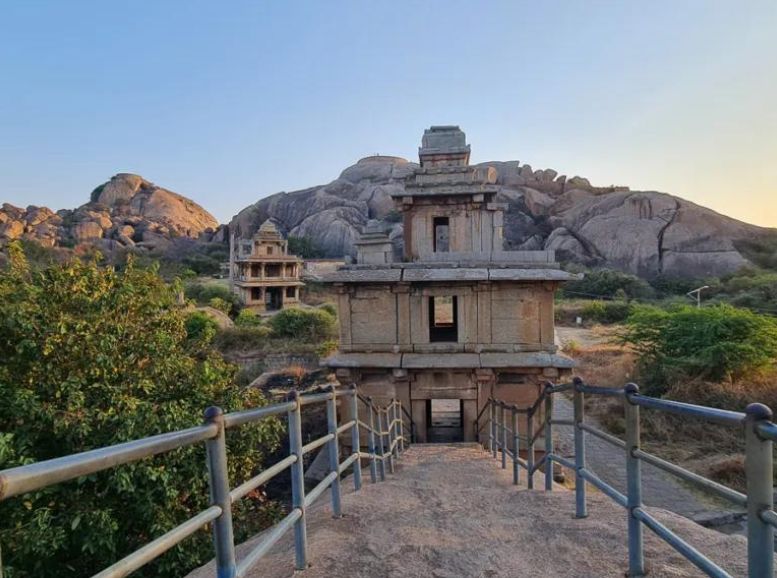
Chitradurga Fort’s imposing gates, collectively called Kallina Kote (meaning “Gates of Stone”), stand as silent guardians, their very presence a testament to the fort’s historic significance. Each gateway, crafted from colossal stones and adorned with intricate carvings, whispers tales of past grandeur and military might.
The Jayamangali Gate, a masterpiece in itself, serves as the grand entrance. Ornate sculptures and delicate patterns embellish its facade, welcoming visitors into the heart of the fortress. As you step through this formidable portal, a sense of history washes over you. The air vibrates with the echoes of battles fought and victories won centuries ago, offering a glimpse into the fort’s strategic importance and its storied past. Prepare to embark on an immersive journey through time within these very walls.
Onake Obavva’s Kindi:
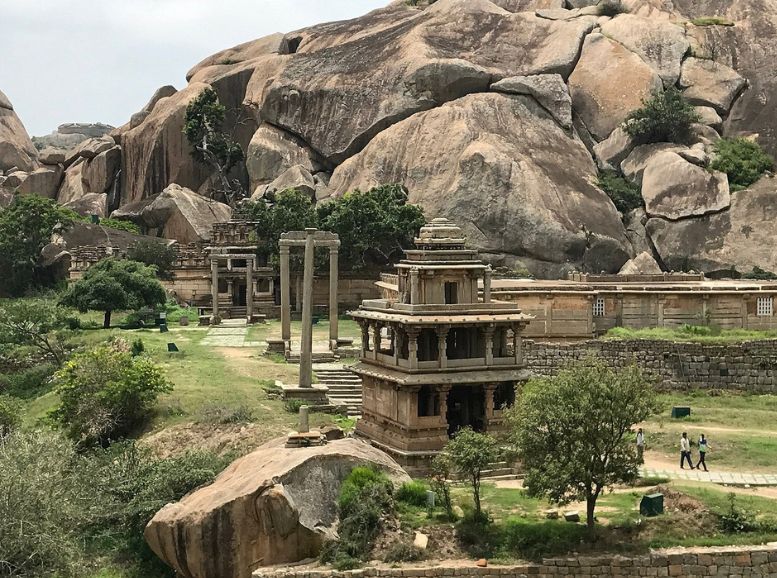
High atop a rocky outcrop within Chitradurga Fort lies Onake Obavva’s Kindi, a poignant symbol of courage and sacrifice. Carved from the very rock itself, this narrow opening played a pivotal role during a historic battle. Legend tells the tale of Onake Obavva, a soldier’s wife, who single-handedly defended the fort by repelling enemy soldiers attempting to enter through this passage. Her bravery has been etched in folklore, and the site continues to inspire awe and reverence. Visitors pay homage to her indomitable spirit, a testament to the unwavering resilience that guards this historic fort.
Fort Walls and Bastions:
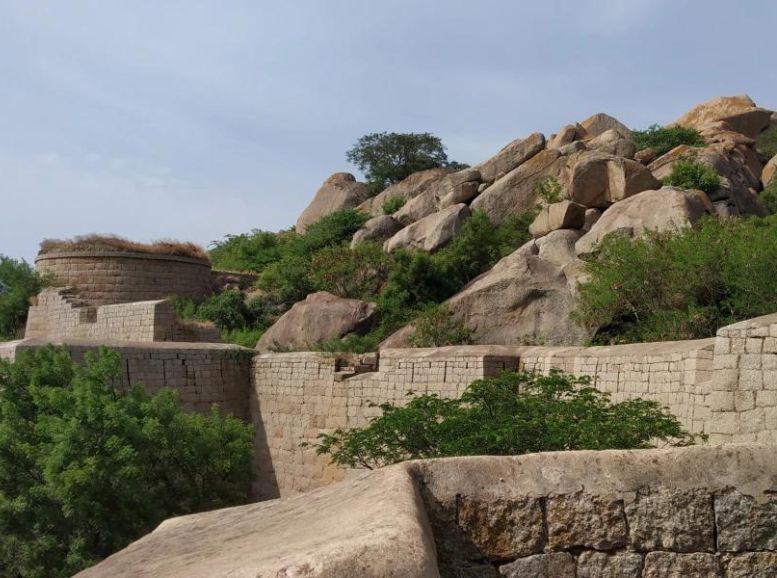
Chitradurga Fort’s rugged landscape bristles with towering stone walls and imposing bastions. These formidable structures, built from local granite and limestone, form an impregnable ring around the fort, a testament to the architectural brilliance and military might of its creators.
As you traverse the labyrinthine pathways along the ramparts, the past comes alive. Imagine the echoes of epic battles and the unwavering resolve of defenders. Each stone whispers tales of resilience, a silent tribute to those who once called Chitradurga Fort home.
Chandravalli Caves, Chitradurga Fort:
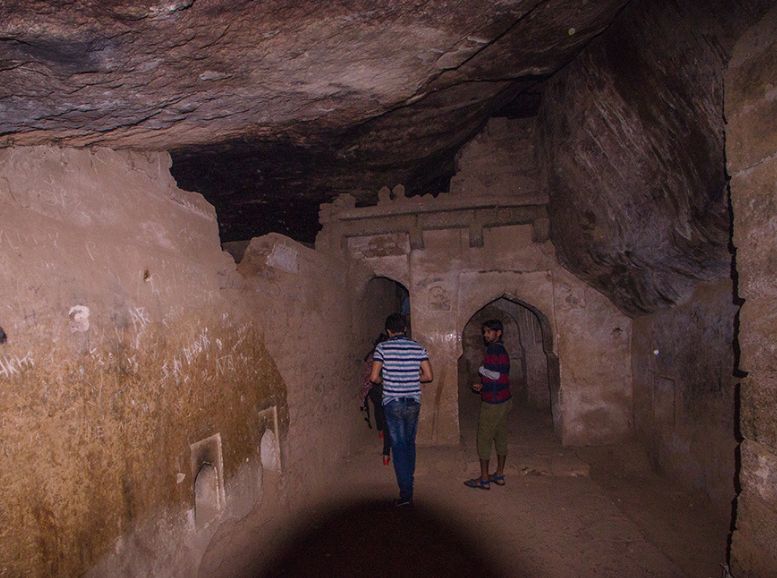
Beyond the imposing walls of Chitradurga Fort lies another captivating chapter of history – the Chandravalli Caves. Tucked away amidst the rugged landscape, these natural limestone caves and rock shelters whisper tales of Karnataka’s ancient past. Dating back to the prehistoric period, they have yielded a treasure trove of archaeological finds – pottery, tools, and even artwork from a bygone era.
The cave walls themselves are adorned with primitive paintings and carvings, offering a unique window into the lives and cultural practices of our distant ancestors. As you explore these ancient caverns, imagine the daily routines that unfolded here. Each step transports you back in time, where the whispers of the past echo through the corridors of stone, a testament to human survival, creativity, and the enduring spirit that has always resided within us.
Ancient Temples:
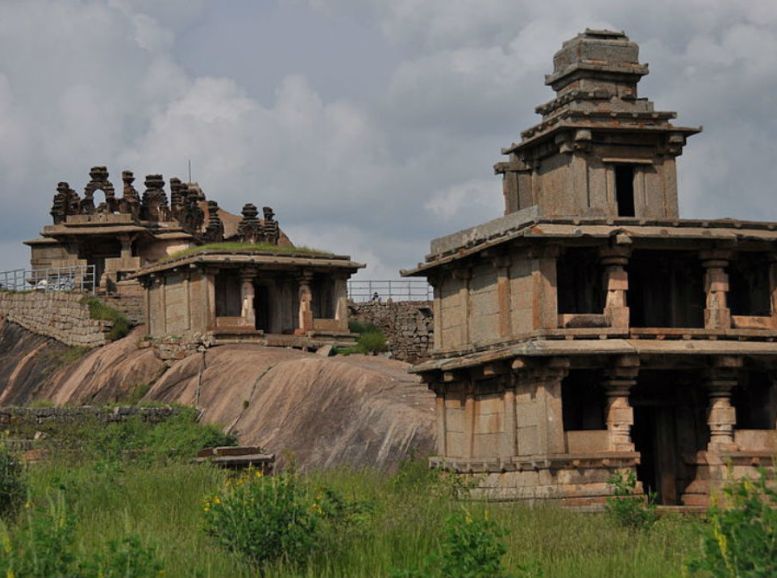
Step beyond the fort’s ramparts and discover another facet of Chitradurga’s rich heritage – its ancient temples. Each structure is a testament to Karnataka’s vibrant religious tapestry.
The Hidimbeshwara Temple, shrouded in mystique, is dedicated to the demon king Hidimba. Intricate carvings and sacred sanctums evoke a sense of awe. The Ekanatheshwari Temple, a beacon of devotion, is dedicated to the goddess Parvati. Pilgrims and devotees from all corners seek blessings within its hallowed halls. Finally, the Anjaneya Temple, revered for its ancient rituals, honors the monkey god Hanuman. Here, weary travelers and worshippers alike find solace and spiritual sanctuary. As you wander through these shrines, an atmosphere of reverence and tranquility washes over you. The divine presence seems to emanate from every stone and statue, creating a truly unforgettable experience.
Tanniru Doni (Water Pond):
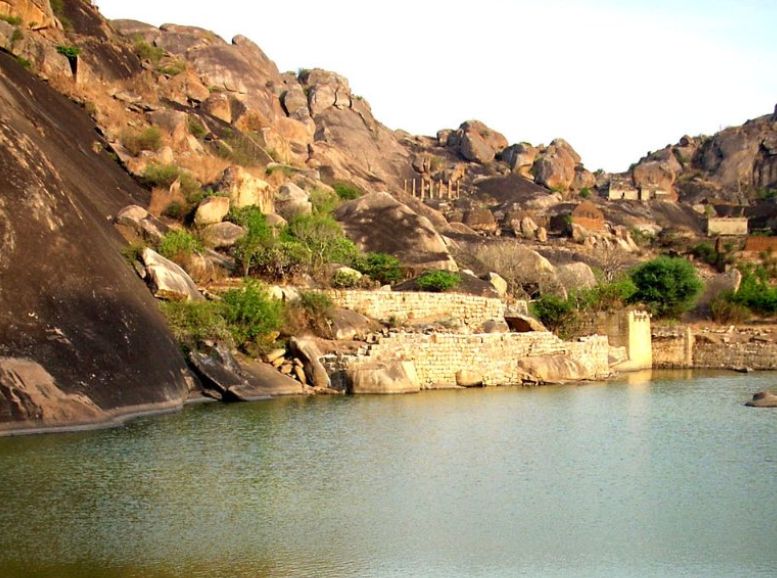
Delve deeper into Chitradurga Fort and discover a hidden gem – the tranquil Tanniru Doni. Nestled amidst the rugged terrain, this historic reservoir served as a lifeline for generations. Natural springs and monsoon rains fed this ancient waterbody, a crucial source of sustenance for the fort’s inhabitants, especially during times of siege.
Surrounded by lush greenery and dramatic rock formations, Tanniru Doni offers a serene escape. The gentle ripples of the water dance in the sunlight, creating a peaceful haven. As you stand by its shores, take a moment to appreciate the resilience and ingenuity of those who built and maintained this vital source of life amidst the harsh realities of life within the fort walls.
Local Experiences:
- Explore Charming Villages: Venture beyond the fort walls and discover the quaint villages that paint a picture of rural Karnataka. Mingle with friendly locals and gain insights into their unique customs. Witness age-old traditions come alive, from the art of pottery making to the intricate patterns woven on handlooms.
- A Taste of Karnataka: Tantalize your taste buds with authentic Karnataka cuisine at local eateries. Savor the comforting flavors of Bisi Bele Bath (lentil rice) and Jolada Roti (flatbread made from millet). Don’t miss the chance to indulge in local specialties like Davangere Benne Dosa, a melt-in-your-mouth dosa made with butter.
- Art & Handicraft Workshops: Unleash your creativity by participating in pottery, bamboo weaving, or painting workshops. Learn from skilled local artisans, mastering traditional techniques that have been passed down for generations. As you create your own masterpieces, support local crafts and contribute to the preservation of this rich cultural heritage.
- Folk Performances & Cultural Shows: Immerse yourself in the vibrant cultural tapestry of Karnataka by attending captivating folk dance performances like Dollu Kunitha (drum dance) and Yakshagana (a unique blend of dance, music, and storytelling). Witness the rich traditions come alive through captivating dance moves and rhythmic music.
- Agricultural Activities & Farm Experiences: Get your hands dirty and experience the joys of rural life! Participate in farming activities alongside local farmers. Learn about organic farming practices and the art of crop cultivation. Gain a deeper understanding of the farmer’s way of life and the importance of agriculture in sustaining communities.
- Local Markets & Shopping: Explore the bustling markets of Chitradurga town, teeming with vibrant colors and local treasures. Shop for fresh produce, fragrant spices, colorful textiles, and handcrafted souvenirs. Don’t hesitate to interact with friendly vendors and engage in good-natured bargaining to find the best deals.
- Community Homestays & Village Tourism: Immerse yourself in the local culture by staying with welcoming families in their traditional homes. Savor delicious home-cooked meals prepared with fresh, organic ingredients. Participate in cultural exchanges and interactive sessions with your hosts, gaining a deeper understanding of their way of life.
Explore the Natural Beauty:
- Nature Walks & Eco-Tourism: Embark on guided nature walks through scenic trails, breathing in the fresh air and soaking in the tranquility of the landscape. Go birdwatching and spot a variety of avian species flitting amongst the trees. Explore nearby hills and forests on eco-friendly treks, appreciating the beauty of nature while minimizing your impact on the environment.
Travel tips:
- Prime Time: Aim for the winter months (October to February) or the post-monsoon season (September to October) for pleasant weather and comfortable sightseeing.
- Comfortable Clothing and Sturdy Shoes: Pack clothes that allow for movement and sturdy shoes for navigating uneven terrain. The fort involves climbing and walking.
- Pack Smart: Bring a refillable water bottle and snacks to stay hydrated and energized during your exploration. Food options within the fort might be limited.
- Cultural Sensitivity: Dress modestly when visiting temples and religious sites. Be mindful of local customs and traditions. Preserve the heritage by avoiding littering or damaging historical structures.
- Entry Fees and Timings: Research entry fees, opening hours, and any special guidelines before your visit to avoid surprises.
- Protect Yourself: Especially during midday excursions, apply sunscreen, wear a hat, and carry sunglasses to shield yourself from the sun.
- Crowded Spaces: The fort can get crowded, so stay alert and keep an eye on your belongings to prevent theft or loss.
- Local Guides: Consider hiring a local guide for a deeper understanding of the fort’s history, architecture, and significance.
- Trekking and Climbing: If you plan on exploring the fort’s ramparts or higher vantage points, exercise caution and follow safety guidelines to avoid accidents.
- Respectful Photography: Take pictures to commemorate your visit, but be respectful of others’ privacy and avoid intrusive behavior.
Conclusion
Steeped in Karnataka’s rich history and architectural brilliance, Chitradurga Fort is a captivating journey through time. Explore ancient corridors, imposing ramparts, and intricate temples, and be transported back to an era of epic battles and enduring resilience. But Chitradurga offers more than history; it’s a gateway to authentic rural life, vibrant cultural traditions, and immersive experiences. From feeling the awe of Onake Obavva’s bravery to indulging in local cuisine or even working alongside farmers, every moment is a discovery. Xplro.com can help you plan your Chitradurga adventure – explore our website for comprehensive travel guides, insider tips, and hidden gems waiting to be unveiled.
FAQs
- What is the historical significance of Chitradurga Fort?
- Chitradurga Fort holds historical importance, tracing its origins back to the 10th century, serving as a strategic stronghold for various ruling dynasties.
- What makes Chitradurga Fort a must-visit destination?
- Its architectural grandeur and rich historical legacy render it a compelling destination, particularly appealing to history enthusiasts.
- What are the visiting hours and entry fees for Chitradurga Fort?
- Chitradurga Fort welcomes visitors daily from 8:00 AM to 6:00 PM, with entry fees typically amounting to around INR 25 for Indian nationals.
- How long does it take to explore Chitradurga Fort thoroughly?
- Exploration duration varies, with a casual visit often lasting 2 to 3 hours, while enthusiasts may dedicate more time to delve deeper into its history and architecture.
- Are guided tours available at Chitradurga Fort?
- Yes, knowledgeable local guides offer insightful tours, shedding light on the fort’s history, architecture, and strategic importance.
- Is Chitradurga Fort accessible for differently-abled visitors?
- Though efforts have been made to improve accessibility, certain sections may present challenges due to uneven terrain and staircases.
- What are the main attractions within Chitradurga Fort?
- Notable attractions include ancient temples, scenic spots like Tanniru Doni, and historical landmarks such as Onake Obavva’s Kindi.
- Can visitors take photographs inside Chitradurga Fort?
- Photography for personal use is generally permitted, with visitors advised to adhere to any specified guidelines or restrictions.
- Are dining facilities available inside Chitradurga Fort?
- While dining options within the fort are limited, nearby food stalls cater to visitors, who are encouraged to carry water and snacks.
- Is Chitradurga Fort suitable for family outings with children?
- Yes, it offers a blend of education and exploration suitable for families, though parental supervision is recommended, especially in areas with steep inclines or historical structures.
- What accommodation options are available near Chitradurga Fort?
- Numerous accommodation choices, including hotels, resorts, and guesthouses, are available in Chitradurga town and its vicinity.
- Are there other attractions near Chitradurga Fort worth exploring?
- Indeed, nearby attractions like Chandravalli Caves and Jogimatti Hill offer additional avenues for exploration and enjoyment.





